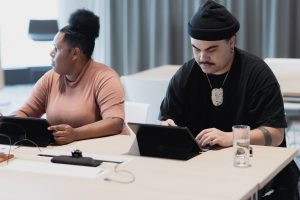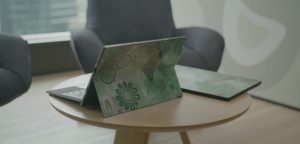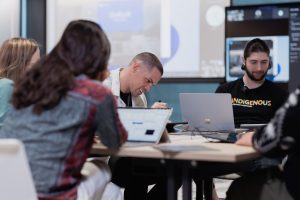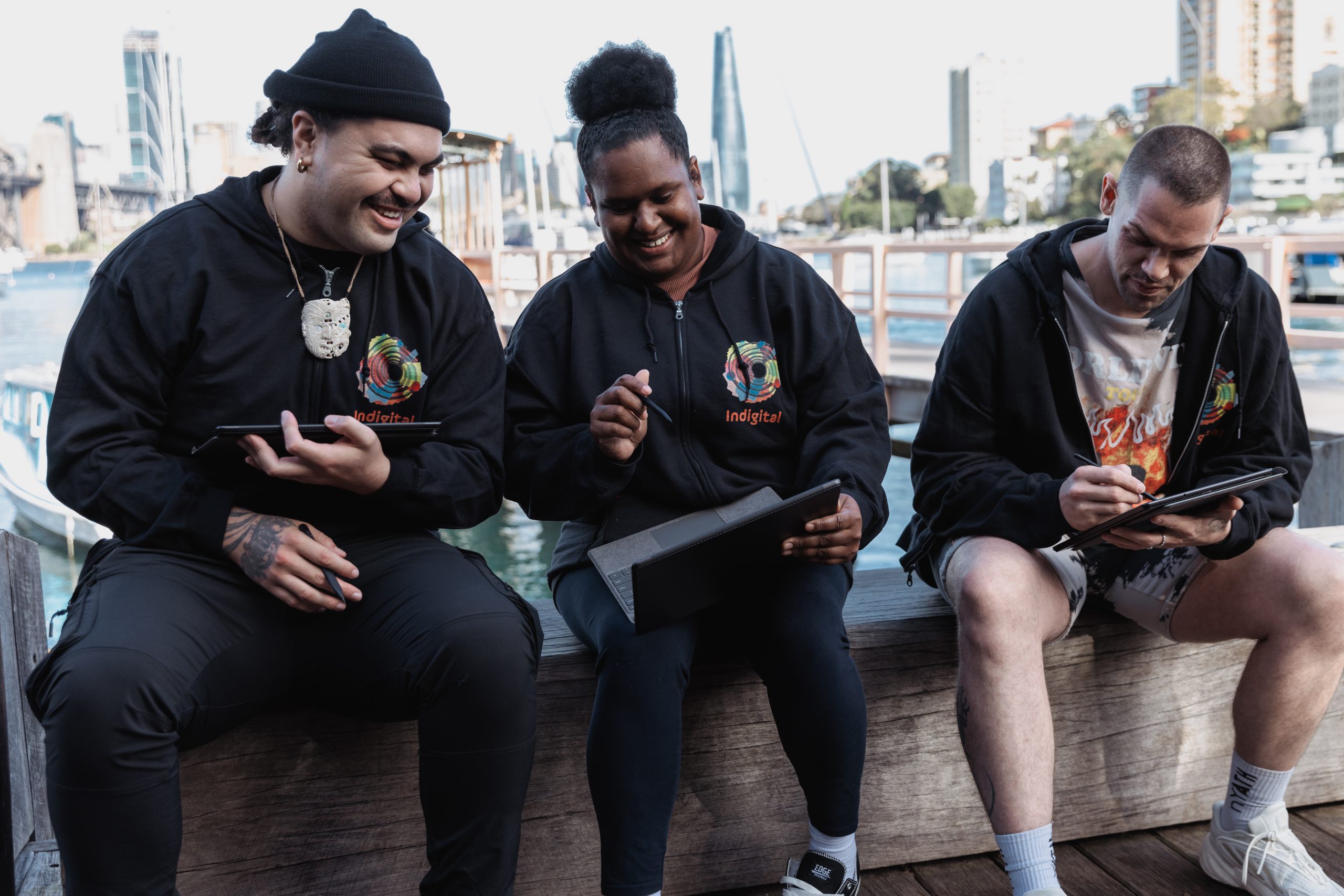Tokotoru ngā ringatoi, e toru ngā iwi, kotahi te mātātuhi rerehua
E ai ki tā Mikaela Jade, he uri nō te iwi Cabrogal, kāore e kore ka hiahia ngā tūpuna kia whakarewahia ake ngā tikanga me ngā taonga tuku iho e ngā hangarau hōu. Kei wareware, e ai ki tāna he iwi pohewa atu ki te āpōpō ngā Iwi Taketake. Heoi, ko ā rātou mahi toi, o rātou mātauranga, reo, tikanga hoki he mea whakairi, he mea tā rānei ki ngā papanga ātaahua hei tirotiro mā te marea.
Ka rere te pātai ki a ia anō – ka ahatia ki te toro atu te ringa auaha o ēnei momo whakaaro ki tōna taumata? Ka pēhea rā te whakamahi i ngā hangarau hōu ki te whakarewa ake i ngā tikanga me ngā mātauranga taketake o ngā manomano tau kua taha ake?
Koia nei ngā pātai ārahi mō tōna pakihi, Indigital, te kamupene Hangarau Mātauranga tuatahi e whakahaerehia ana e te tangata taketake. Ko tōna whāinga matua ko te āwhina i ngā Iwi Taketake ki te mau, ki te whakaora hoki i ō rātou pūrākau tuku iho mā ngā hangarau o nāianei pēnei i te tirohanga mariko, te ao mariko, te roro rorohiko me te mīhini ako.
Nō nā tata nei karangahia ai ngā ringatoi Tangata Taketake e toru — Lala Gutchen nō te motu o Erub (Darnley), Kobi Sainty nō Naarm (Melbourne), Tawhanga Rika nō Rotorua, ko Te Arawa te iwi me te waka, ko Ngāti Rangiwewehi, Tūhourangi-Ngāti Wahiao, Ngāti Tarāwhai, Ngāti Umutahi, Ngāti Whakaue ngā hapū — hei raranga atu i ō rātou tāera toi rerekē mō te papatuhi Microsoft Surface.
I pau ngā marama maha e mahi tahi ana – kanohi ki te kanohi tuatahi atu, mā te Microsoft Teams tuarua atu, nā wai nā wai ka oti, ā, ka taea e te tangata te whakamuramura, te whakaohooho i te uhi o tōna Surface*.
Ko te hoahoa nei he mea karanga ki ngā rangatahi Māori, rangatahi Iwi Torres Strait, rangatahi Tangata Taketake hoki, ki te whakanui i a ia anō, te takenga tūturu o ngā pūtaiao, ngā hangarau, ngā taputapu me ngā pāngarau. He mea whakamaumahara hoki – ko ngā taputapu e whakamahia ana ia rā, ia rā —he mea kore whakaaro i te nuinga o te wā — he mea i takea mai i ngā mātauranga taketake o ngā manomano tau kua taha ake.

Te mahi tahi
Whai muri i te whakawhitiwhiti kōrero taketake (mō te reo me ngā momo tikanga) ki te tari matua o Microsoft ki Poihākena, i puaki te āmaimai i te tokotoru.
Ka pēhea ngā momo me ngā tāera rerekē e raranga tahi ai? Kia tika ai, kia ātaahua ai, te uhi o te Surface?
I ngā rua rā e mahi tahi ana, ka whai whanaungatanga i ngā whetū o te rangi mai rā anō – he momo o tēnā iwi taketake, o tēnā iwi taketake.
“Koia nei te hononga – ko ngā whetū me ngā āhuatanga kōkōrangi” tā Tawhanga, he uri e noho ana ki te pā o Te Whakarewarewa ki Rotorua.(“This is how we are all connected because we all have a star that navigates us,”.
“Ki ahau nei, he momo Māori anō a Kobi rāua ko Lala, he tangata taketake, pēnei i a au, ā, ka rongo rāua i tāku i rongo ai, ka rongo au i tā rāua i rongo ai.” (“I kind of look at Kobi and Lala as another Māori, another native like myself, and then I can relate to a lot of what they say and what they do.”) “Nā whai anō he mea mīharo te hononga”.
E whakaae ana a Lala, he wahine Erub nō te iwi Meuram i Torres Strait, “he maha ngā ōritetanga nō reira he hononga hoki i a mātou e mahi tahi ana ki te waihanga i tēnei mātātuhi toi”. (“Most of us have similarities, so we can really link with each other to create the artwork for the collaboration.”)
“He mea whakangāwari ērā momo whakawhitiwhiti kōrero pūrākau, ngā hononga, ngā ōritetanga, ngā momo ahurea, ngā whetū, ngā moemoeā” – e ai ki tā Kobi, he uri nō Bunurong me Palawa me te iwi Kulin i te Rāwhiti-ki-te-Tonga. (things “flowed really easily” as the group “chatted about stories, similarities and connections across Our Peoples, Dreamtimes and stars.”)
Te raranga i ngā tāera o tēnā, o tēnā
Ko te mātātuhi whakamutunga mō te Surface he mea raranga i ngā āhuatanga o te ātea, ngā wai mauri ohooho, ngā kākahu upoko taketake, ngā rore ika kōhatu, ngā wānanga huinga porohita, te taiao taurikura, ngā hoahoa taketake me ngā tānga moko.
He mea whai take ia āhuatanga: He wahine hī ika a Lala, ā, ko te moana te wāhi e rongo ai ia i te hononga ki ōna tūpuna. He hokinga mahara ki a Kobe ngā wānanga e huihui porohita ai ngā tāngata ki te whakawhiti kōrero ki ērā atu ringatoi. Ko te wāhi ki a Tawhanga ko te whakamana i ngā mātāpuna wai me ngā ngāwhā o tōna pā – ngā āhuatanga e whai wāhi ai ki ōna moko i takea mai i ōna tūpuna.
Ko ngā tohu hoahoa nei he tohu tūāpapa mō tēnā, mō tēnā o ngā ringatoi taketake nei me ō rātou ao tukupū.
“Ko ngā Iwi Taketake he tāngata taiao, ko te whenua tērā, ko te wai tērā, ko te rangi tērā” te kōrero o Mikaela. (“First Nations Cultures centre on Country, and Country means our lands, our water, our Sky Country.”) “He mea pārekareka ki a au te hononga o tēnā ki tēnā nā runga i ngā tikanga me ngā whakapono e hāngai ana ki ngā whetū o te rangi – ngā tikanga tuku iho o te tangata taketake”. (“I think it’s beautiful that the artists have looked up to the sky and have connected each of their cultures through the stars in the most traditional of ways.”)
Ahakoa te uaua ki te hono atu ki te ipurangi mō Lala, ka puaki te pātai i a ia “E pēhea rā ahau e toro atu ki ngā tāngata huri noa i te ao ki te kore ēnei momo hangarau?” (“how else is she supposed to reach a global audience if she doesn’t have these kinds of platforms available to her?”)
Lala Gutchen @privvgutchen_islandlife
Kei te whai atu a Lala i ngā iti kahurangi tino teitei rawa atu, ā, he pūkenga hoki ōna ki te eke ki aua taumata. He uri ia nō te whānau ringa raupā, te whānau ringa toi, ā, ko ia tētahi o te torutoru i tōna motu e ū ana ki ngā mahi toi peita kiriaku. I toa ia i te whakataetae toi i a ia e tamaiti ana, nā wai nā wai ka oti i a ia te tohu toi taketake me te toi ao hurihuri. Ko tāna e whai atu nei ināianei ko te waihanga i te puka-hiko me te pakiwaituhi mō tōna iwi me tōna reo mō ngā rangatahi o tōna hapori me ērā e noho ana i te tuawhenua.
I mua i tōna mahi ki Indigital ko tāna he tā ki te pepa, ki te papanga rānei kātahi ka tā i tētahi anō papa wāhanga o te pikitia, kātahi tētahi anō, ā, mea rawa ake kua oti te pikitia.
“He mea hōu ki a au te papa matihiko me te ranunga o ngā tae rerekē” tāna. (“Putting my artwork onto a digital screen was a new thing for me when it came to looking at and mixing colours,”) “Heoi, kia tuhia rā anō ki te mata he ngāwari te whakatika i ngā hapa, te panoni rānei i tētahi wāhanga”. (“But I like that once it’s on the screen, you can always go back to it and make changes easily or backtrack,” she says.)
E ngākau nui ana ia ki te whakarauoratanga o tōna reo taketake, ā, nā te raweke i ngā taputapu matihiko i puaki te wawata i roto i a ia ki te toro atu i te ringa o whanaungatanga ki ērā atu ringatoi nō ngā Iwi Taketake.
“Hīkaka ana te ngākau i te kitenga i ngā rangatahi o te motu e ruku ana ki ngā mahi toi matihiko me ngā taupānga o taua ao”. (“It’s also exciting to see younger people on the Island get into digital art and use apps”.)
Tawhanga Rika @rauruarts
I ruku hoki a Tawhanga ki ngā momo tāera rerekē whai muri i tōna ūnga ki te Surface Slim Pen me ōna pūkenga whakakore hapa, whakatārua pikitia hoki. I te mea he kaitāmoko ia, i kore ia i āhei ki te panoni i ngā moko i tāngia ai. Heoi, i ngākau whānui ia ki ngā ara rerekē ki te whakaatu atu i āna mahi toi me tōna ahurea ki te ao matihiko.
“He māori noa tēnei āhuatanga ki a mātou, te toi, ā, ka taea e te tangata taketake te huri ki ēnei āhuatanga hōu, he momo nō mātou.” (“This is a natural thing for us, creating art, and I feel like Indigenous Peoples can adapt easily to these types of things — obviously”.) Ki te whai wā mātou ki te rāweke i ngā taputapu hōu, kāore e roa ka māori noa iho ki te ringa taketake – he mea tuku iho tērā.” (“We just need to learn how to use the tools, but we’ve been doing this since before time.”)
He pāpā ia, ā, he kaha hiahia nōnā ki te toha i tōna whakapapa ki āna tamariki mā te toi – he mea tuku iho, pēnei i ngā momo tuku iho o ōna tūpuna.
Ka whai wāhi atu ki āna mahi toi te raranga, te whakairo rākau, poroiwi, kōhatu me ngā toi whakaari e whai wāhi nui ai ki tōna iwi, ā, he ara anō te ao matihiko ki te “whakatairanga, whakaora, tiaki hoki i ngā taonga tuku iho me ngā tikanga o te Māori.” (“Promote, preserve and share the Māori culture, our hearts and traditions.”)
Kobi Sainty @kobisaintyart
E mihi ana a Kobi ki ōna kaumātua me ērā atu ringatoi nā rātou i titi te whakahirahira o te whanaungatanga ki roto i a ia. Ahakoa kāore ia i tino whakapono he ringatoi ia, whai muri i tāna mahi ki Indigital ka riro atu āna whakaako ki ngā mahi toi peita wai mā ngā taupānga o te Surface, me tana ohorere ki te tere māori haere o te taputapu rā ki ōna ringa.
“I te toi matihiko, ka ngana nei au ki te peita i ngā papa pikitia huhua nei, anō nei he papanga pepa tāku i tāngia ai” tāna. (“With digital art, I try to layer as much as I can as if it was a canvas,” he says.) “Kei te hiahia tonu au kia kitea ngā papanga rerekē kia tūturu ai te āhua.” (“I want it to still get that texture and different gradients and seem as real as it can be.”)
Ki tā te āpiha mātauranga nei, he ara anō ngā taputapu matihiko ki te whakairi i ngā kōrero me ngā pūrākau o tōna iwi i a ia e ruku ana ki ngā āhuatanga o te whenua taketake.
Ko tōna wawata – kia tūwhera i a ia ngā tatau o te wharetoi, ā, ko tāna i tēnei wā he whakarite wānanga mō ngā rangatahi Iwi Taketake ki te āwhina i a rātou ki te pīkau i ō rātou whāinga toi.
“Ka kite ana te rangatahi i ēnei momo kaupapa, ka whakapono ia ka taea tēnei ao, e taea ai te nanaiore atu”. “Ka kite i ā mātou mahi toi, ā, ka puāwai te whakapono e taea hoki tā rātou mahi toi te pīkau.” (“People will be able to see our artwork and aspire towards their own creative vision.”)
Te āpōpō
I te mea he pūkenga matihiko ki ngā mahi e iwa o tekau, he tino whakahirahira kia kite ai ngā rangatahi Iwi Taketake i te wāhi ki a rātou i te ao toi — mā reira e taea ai te whiwhi moni, te whakairi ki te taupānga Country, te ū ki ngā kaupapa taketake, me te whakamārō i ngā herenga tangata me ngā herenga iwi mēnā e hiahiatia ana.
Ka kite atu te kāhui Indigital i te pakari haere o te ringa me te hinengaro o te rangatahi ki ngā hangarau hōu, ā, ka huri te rangatahi mai i te āmaimai me te whakamā ki te mauri ohooho me te mauri mīharo ki tēnei ao.
Ko tā Mikaela mō te hononga pūmau ki a Microsoft – “I tīmata atu ko tā mātou he waihanga i ngā ataata mō te tangata, ināianei ko tā mātou he akiaki i te tangata ki te waihanga i ōna ake pūrākau.” (“We went from developing holograms for people to empowering people to develop their own storytelling,”) “Ko te mea tino whakahihiko i a au ko te kite atu i te whakapono e puāwai ana i roto i te tangata – te whakapono “Āe, ka taea e au”. (“The real thing that gets me out of bed every day is seeing that transformation when someone believes they can do it.”)
Ko ēnei uhi Surface he mea taki i te whanaungatanga ahakoa ki hea i te ao, he mea taki hoki i te pitomata o Ngā Iwi Taketake i tēnei ao hangarau.
“Ko tā mātou e hiahia ko te whakaohooho i ngā iwi taketake kia koke whakamua ai, kia whai whakaaro atu ki te nāianei, ki te āpōpō hoki,” tāna. (“We want to inspire our people not just to look backwards at our culture, but to move forward and consider what Our Peoples are today, and what we’d like to be in the future,” she says.)
Ka whai wāhi atu mātou ki te whakaputa i ngā kare ā-roto i ēnei momo kaupapa, ka whai wāhi hoki ki te pōhewa atu ki te nāianei me te āpōpō mō tātou – te Tangata Taketake, te tangata taketake nō te motu o Torres Strait, te Māori rānei. (“Projects like this allow us to express ourselves as futurists and to be able to imagine what it is to be an Aboriginal person, Torres Strait Islander or Māori in the 21st century and beyond.”)
*Ka riro katoa ngā pūtea i taka iho ki ngā ringatoi
Three artists, three cultures, one incredible artwork
Mikaela Jade, a Cabrogal woman, is sure her Ancestors would have wanted their culture upheld through the newest tools available. After all, she says, First Nations Peoples have always imagined their cultures in the future. However, their artwork, knowledge, language, and law are still most frequently seen in galleries and put onto beautiful fabrics.
What would happen if these traditional modes of expression were pushed, she wondered? How could technology be used to capture and amplify tens of thousands of years of cultural knowledge systems as well?
These are the questions her company, Indigital, Australia’s first Indigenous-led EduTech startup, is asking. Their mission is to support First Nations Peoples in preserving and proliferating their own stories through technologies including augmented and mixed realities, AI, and machine learning.
Most recently, they invited three First Nations artists — Lala Gutchen from Erub (Darnley) Island, Kobi Sainty from Naarm (Melbourne), and Tawhanga Rika (Te Arawa, Ngāti Rangiwewehi, Tūhourangi-Ngāti Wahiao, Ngāti Tarāwhai, Ngāti Umutahi, Ngāti Whakaue) from Rotorua — to merge their creative styles in a ‘wrap’ for Microsoft Surface devices.
After months of working together, in-person then virtually on Microsoft Teams, their completed artwork is now available for Surface users to bring the front of their device to life*.
The design invites the next generation of Māori, Torres Strait Islander and Aboriginal youth to celebrate their history as the original scientists, technologists, engineers, and mathematicians. It also provides a unique reminder that the devices we use every day —sometimes without a thought — are built upon tens of thousands of years of unbroken Indigenous knowledge.
Finding common ground

When first introduced culture-way (exchanging their mother tongues and cultural expressions) at Microsoft’s Sydney office, there was some trepidation between the trio.
How would their artistic styles mesh, they wondered? And be captured on the front of a Surface device?
Over the course of a two-day workshop, they bonded over how the night sky, like all their cultures, has existed since the dawn of time.
“This is how we are all connected because we all have a star that navigates us,” says Tawhanga, who is based in Whakarewarewa Village, Rotorua.
“I kind of look at Kobi and Lala as another Māori, another native like myself, and then I can relate to a lot of what they say and what they do,” he says. “And so that makes it really special.”
Lala, an Erub woman from the Meuram tribe in the Torres Strait, agrees that “most of us have similarities, so we can really link with each other to create the artwork for the collaboration.”
Kobi, a Bunurong and Palawa man from South-Eastern Kulin Nation, also appreciates how things “flowed really easily” as the group “chatted about stories, similarities and connections across Our Peoples, Dreamtimes and stars.”
Bringing it all together
Their final Surface wrap artwork is composed of cosmic overlays, vibrant waterways, traditional headdresses, stone fish traps, Yarning Circles, lush nature and traditional tāmoko designs and weaving symbols.
Each element is intentional: Lala is a fisherwoman, feeling most connected to her ancestors while at Sea Country. Kobi was reminded of his Peoples gathering in a circle while exchanging stories with the other artists. And Tawhanga wanted to honour the fresh spring water and hot springs that surround his village, which influence his work alongside the tattoo art he shares with his tīpuna (ancestors).
All the symbols are fundamental to how each artist’s community understands their place not just in the world, but the universe too.
“First Nations Cultures centre on Country, and Country means our lands, our water, our Sky Country,” Mikaela considers. “I think it’s beautiful that the artists have looked up to the sky and have connected each of their cultures through the stars in the most traditional of ways.”
While it was a challenge to coordinate internet access for Lala, she asks: “how else is she supposed to reach a global audience if she doesn’t have these kinds of platforms available to her?”
Lala Gutchen @privvgutchen_islandlife
Lala has sky-high ambitions and the talent to match. Hailing from an extended family of artists and craftsmen, she is one of a few acrylic painters on her island. After winning an art competition as a child, she completed diplomas in Cultural and Western Visual Arts. Her sights are now set on creating an interactive e-book, animation, and cartoon series about her culture and language for the youth in her community and those living on the mainland.
Before working with Indigital, she was used to drawing on paper or painting on canvas, then stepping back and layering over the top several times to create her art.
“Putting my artwork onto a digital screen was a new thing for me when it came to looking at and mixing colours,” she says. “But I like that once it’s on the screen, you can always go back to it and make changes easily or backtrack,” she says.
The language facilitator, passionate about preserving her native Erub Mer language, found working with digital tools deepened her desire to collaborate with other First Nations artists.
“It’s also exciting to see younger people on the Island get into digital art and use apps,” she says.
Tawhanga Rika @rauruarts
Tawhanga also found the Surface Slim Pen’s mirror imaging and erasing capabilities emboldened him to experiment further with his artistic style. As a traditional Māori tattoo artist, specialising in tā moko, he wasn’t usually able to make changes once his designs were complete. But he welcomed finding new ways to bring his culture and artforms into the digital world.
“This is a natural thing for us, creating art, and I feel like Indigenous Peoples can adapt easily to these types of things — obviously,” he says. “We just need to learn how to use the tools, but we’ve been doing this since before time.”
As a father of two, he wants to share his past and whakapapa (genealogy) with his kids through stories around their ancestry and art, as his elders did for him.
Drawing inspiration from weaving, traditional wood, bone, and stone carving, and the performing arts at the heart of his community, he now sees digital artwork as another avenue to “promote, preserve and share the Māori culture, our hearts and traditions.”
Kobi Sainty @kobisaintyart
Kobi is grateful his grandparents, also creatives, instilled a deep sense of community connection in him. Though he didn’t always consider himself an artist, after working with Indigital he became drawn to layering watercolour art through the creative apps on his Surface device and was surprised with how natural it felt.
“With digital art, I try to layer as much as I can as if it was a canvas,” he says. “I want it to still get that texture and different gradients and seem as real as it can be.”
The language education officer feels digital tools give him another way to creatively tell his community’s story, which he is immersing himself in by spending time on Country.
With dreams of opening a studio, he currently runs workshops for other First Nations youth to help them see the value in pursuing their creative goals.
“Projects like this mean they’re seen and there are paths opening for them to be able to have accessible goals,” he says. “People will be able to see our artwork and aspire towards their own creative vision.”

Looking to the future
With nine out of ten jobs requiring digital skills, showing young Indigenous creatives the opportunities that the creator economy provides — to commercialise their work, conduct it on Country and continue their cultural connections and responsibilities if they choose — is crucial to closing the digital divide.
The Indigital team sees hesitation turning to awe daily as students in their regional and remote programs gain confidence in harnessing new technologies.
“We went from developing holograms for people to empowering people to develop their own storytelling,” Mikaela says of their long-standing partnership with Microsoft. “The real thing that gets me out of bed every day is seeing that transformation when someone believes they can do it.”
These latest Surface device wraps, she feels, speak to the need to engage communities wherever they are in the world, and the potential of First Nations Peoples to make it in cutting edge technology.
“We want to inspire our people not just to look backwards at our culture, but to move forward and consider what Our Peoples are today, and what we’d like to be in the future,” she says.
“Projects like this allow us to express ourselves as futurists and to be able to imagine what it is to be an Aboriginal person, Torres Strait Islander or Māori in the 21st century and beyond.”
*Royalties from any sales will be passed on to the artists

